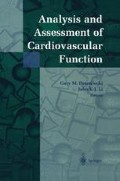Abstract
Despite years of innovative experimentation and the development of numerous models of the coronary circulation, controversy remains over the fundamental mechanisms underlying coronary vascular perfusion. The fundamental reason for this is the inaccessibility of the intramyocardial vessels to direct measurement. The coronary circulation is thus a prime candidate for physiological modeling.
Access this chapter
Tax calculation will be finalised at checkout
Purchases are for personal use only
Preview
Unable to display preview. Download preview PDF.
References
Borg TK, Caulfield JB. The collagen matrix of the heart. Federation Proc. 1981;40:2037–2041.
Bouma P. Coronary blood flow and contraction. Amsterdam: Free University of Amsterdam; 1991. Dissertation.
Downey JM, Kirk ES. Inhibition of coronary blood flow by a vascular waterfall mechanism. Circ Res. 1975;36:753–760.
Flynn AE, Coggins DL, Goto M, Aldea GS, Austin RE, Doucette JW, Husseini W, Hoffman JIE. Does systolic subepicardial perfusion come from retrograde subendocardial flow? Am J Physiol. 1992;262:H1759–H1769.
Frasch HF. Interpretation of coronary circulatory perfusion. Philadelphia: University of Pennsylvania, 1993 (University Microfilms International No. 9413831). Dissertation.
Frasch HF, Kresh JY, Noordergraaf A. Wave transmission and input impedance of a model of skeletal muscle microvasculature. Ann Biomed Eng. 1994; 22:45–57.
Frasch HF, Kresh JY, Noordergraaf A. Two-port analysis of microcirculation: An extension of Windkessel. Am J Physiol. 1996;270:H376–H385.
Fung YC. Biomechanics: Mechanical Properties of Living Tissues. New York: Springer-Verlag; 1981.
Hanley FL, Messina LM, Gratten MT, Hoffman JIE. The effect of coronary inflow pressure on coronary vascular resistance in the isolated dog heart. Circ Res. 1984;54:760–772.
Hoffman JIE, Spaan JAE. Pressure-flow relations in coronary circulation. Physiol Rev. 1990;70:331–390.
Izrailtyan I, Frasch HF, Kresh JY. Effects of venous pressure on coronary circulation and intramyocardial fluid mechanics. Am J Physiol. 1994;267: H1002–H1009.
Kajiya F, Tsujioka K, Goto M, Wada Y, Chen X-L, Nakai M, Tadaoka S, Hiramatsu O, Ogasawara Y, Mito K, Tomonaga G. Functional characteristics of intramyocardial capacitance vessels during diastole in the dog. Circ Res. 1986;58:476–485.
Kassab GS. Morphometry of the coronary vasculature in the pig. La Jolla: University of California, San Diego; 1990. Dissertation.
Katz SA, Feigl EO. Systole has little effect on diastolic coronary artery blood flow. Circ Res. 1988;62:443–451.
Kresh JY. Intramyocardial mechanical states: Vessel-interstitium-muscle interface. In: Sideman S, Beyar R, eds. Interactive Phenomena in the Cardiac System. New York: Plenum; 1994, Chap. 12.
Olsson RA, Bugni WJ. Coronary circulation. In: Fozzard HA, ed. The Heart and Cardiovascular System. New York: Raven Press; 1986:987–1037.
Rabbany SY, Kresh JY, Noordergraaf A. Intramyocardial pressure: Interaction of myocardial fluid pressure and fiber stress. Am J Physiol. 1989;257:H357–H364.
Spaan JAE. Coronary blood flow: Mechanics, distribution, and control. Dordrecht: Kluwer; 1991.
Tomoike H, Ootsubo H, Sakai K, Kikuchi T, Nakamura M. Continuous measurement of coronary artery diameter in situ. Am J Physiol. 1981;240:H73–H79.
Wüsten B, Buss DD, Deist H, Schaper W. Dilatory capacity of the coronary circulation and its correlation to the arterial vasculature in the canine left ventricle. Basic Res Cardiol. 1977;72:636–650.
Rights and permissions
Copyright information
© 1998 Springer Science+Business Media New York
About this chapter
Cite this chapter
Frasch, H.F., Kresh, J.Y., Noordergraaf, A. (1998). Interpretation of Coronary Vascular Perfusion. In: Analysis and Assessment of Cardiovascular Function. Springer, New York, NY. https://doi.org/10.1007/978-1-4612-1744-2_7
Download citation
DOI: https://doi.org/10.1007/978-1-4612-1744-2_7
Publisher Name: Springer, New York, NY
Print ISBN: 978-1-4612-7261-8
Online ISBN: 978-1-4612-1744-2
eBook Packages: Springer Book Archive

